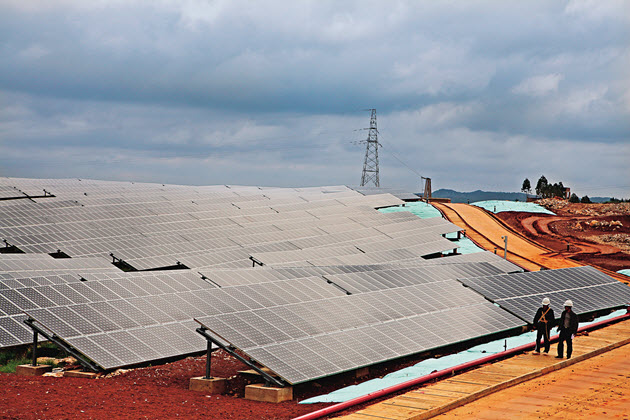China's Unfair Playing Field
Will Taiwan Be Left Nibbling the Giant's Crumbs?

Source:CW
Taiwanese enterprises have never focused on a five-year plan emanating from China as intensely as they are today. But is there really anything in it for them over the long haul?
Views
Will Taiwan Be Left Nibbling the Giant's Crumbs?
By Benjamin ChiangFrom CommonWealth Magazine (vol. 456 )
On the morning of Sept. 16, more than 300 high-tech executives packed a meeting room at the Taipei International Convention Center for cross-strait forum on the "Internet of Things."
"The Internet of Things concept could be incorporated into China's 12th five-year plan. We want to get a jump on being in position to capitalize on the plan's commercial opportunities," says a sales manager of an IC design house in the Hsinchu Science Park, reflecting the true intentions of the companies present.
Taiwan's enterprises have never taken a more intense interest in a Chinese five-year plan than today, their highly sensitive noses for money-making opportunities driving them to ferret out by any means possible the direction of China's 12th five-year plan, which will take effect next year.
As China is now Taiwan's biggest trade partner, and the two countries signed an economic cooperation framework agreement (ECFA) in June, China's development map for the next five years has taken on new importance.
"The 12th five-year plan will directly influence the deployment of Taiwan's industries. Behind the plan's direction lies hundreds of billions in commercial opportunities," says Chang Wu-ueh, the director of Tamkang University's Graduate Institute of China Studies.
At the beginning of September, China announced seven strategic emerging industries, offering a preview of the 12th five-year plan's development priorities. "The first three strategic emerging industries were all related to a low-carbon economy," says John Chen, a researcher at the Market Intelligence & Consulting Institute's China Research Center. They are also key elements of Taiwan's future industrial development.
Last year, China acted like a famished giant, devouring a third of the steel, coal and cotton produced in the world, but its domestic output value accounted for only 8 percent of the global total.
Though the new five-year plan has yet to be formally unveiled, the hints given by China's government clearly highlight its intention to resolve such intractable problems as low value-added and low per-unit production efficiency by extending the 11th five-year plan's emphasis on "indigenous innovation" and strengthening products' value-added.
Accelerating Industrial Restructuring
The most fundamental theme of the 12th five-year plan will be to accelerate the transformation of the country's economic development path through restructuring, which poses a direct threat to Taiwan's industrial base.
"The 12th five-year plan and Taiwan's six major emerging industries have a strong 'co-opetition' relationship. The two sides are both developing the clean energy and biomedical sectors," says Chen. (See Table)
Over the next five years, China's industrial structure will undergo a massive transformation as it eliminates "backward production capacity" and elevates high value-added sectors.
On the surface, the plan may bring Taiwanese-invested companies in China massive opportunities, but a closer look reveals that China's rush to restructure its industrial base poses three major threats to those same Taiwanese enterprises.
Threat No. 1: Higher 'Green' Production Standards
One of the 12th five-year plan's major policies will be to accelerate the rollout of green and energy-saving manufacturing. Companies that do not meet applicable standards should be ready to be shut down.

In August, China's Ministry of Industry and Information Technology took action against backward industries, announcing that over 2,000 companies in 18 sectors guilty of the "three highs" – high pollution, high energy consumption and high green house gas emissions – would be closed down if they did not improve their operations by the end of September.
The message was clear. Manufacturers whose production processes were not environmentally friendly enough should be prepared to be banished from China's coastal areas. The factory manager of a chemical company that set up a plant in Kunshan over a decade ago said he had felt the intense "attention" of the city government, with city officials paying repeated visits to persuade him to relocate the factory inland.
"They no longer welcome industries with pollution here," sighed the graying factory manager.
Threat No. 2: More Closely Controlling Capacity
Under the 11th five-year plan, China's government encouraged enterprises to expand rapidly to promote indigenous innovation, resulting in excess capacity in the cement and automotive sectors.
The 12th five-year plan will address this problem of redundant industrial investment, which will have an impact on Taiwanese businesses in China accustomed to pushing production capacities as high as possible. China's government has grown increasingly strict in managing capacity in certain sectors and no longer blindly solicits investment to avoid supply excesses.
Over the next five years, China is likely to encourage mergers to create internationally competitive companies formed from existing small- and medium-sized enterprises (SMEs) and reduce industrial duplication.
At the same time, China's review of factory applications has become stricter because of more stringent investment thresholds. "It is only soliciting investment from large-scale, competitive companies. Foreign-invested SMEs that lack competitiveness will have a hard time getting approval," predicts Taiwan Cement senior vice president Huang Chien-chiang.
In terms of the cement sector, China's government has clearly stated it will not encourage new capacity, while at the same time pushing for the consolidation of existing cement factories into large-scale companies.
"China's 10 leading cement companies will have to hold a 35-percent share of the country's cement market. The trend is toward larger-scale development," Huang says. China has stipulated that new cement plants must be able to produce 5,000 tons of product a day and that the company investing in the facility put up at least 50 percent of the capital, requirements that SMEs can only look at despairingly.
Threat No. 3: Even More Unfair Competition
China's promotion of seven strategic emerging industries would seem to offer unlimited opportunities, but a closer analysis indicates that, "in many industrial sectors, Taiwan cannot take advantage of the opportunities in front of it. It can only pick up some of the crumbs left behind by large Chinese enterprises," says MIC's Chen.

"The state advances, the private sector retreats" has become the latest catchphrase in China, and with state-run behemoths expanding and industrial consolidation being encouraged, every sector in China is bound to be dominated by a few large players. Add to that protectionist local content requirements, and it becomes obvious that China is holding an unfair competition that makes it nearly impossible for Taiwanese companies to rival China's domestic firms.
In the 12th five-year plan, China's move to steer development toward low-carbon energy industries poses more of a threat than an opportunity for Taiwan.
"In the short term, it would seem to be a big opportunity for Taiwanese businesses in China, but it's a major threat over the long term," says a worried Lin Chih-hsun, director of energy research at the Industrial Technology Research Institute's Industrial Economics & Knowledge Center. Taiwanese businesses that have been sharpening their swords to vie for the vast business opportunities awaiting in systems integration for the new energy industry may end up being nothing more than contract manufacturers for Chinese companies, and earning the slimmest of margins.
To make his point, Lin cites China's wind power industry as an example of how China distorts the market in its favor. Early in its industrial development, China adopted a policy of trading market access for technology transfer, so when China decided to fully promote wind power in 2005, the National Development and Reform Commission opted to protect domestic manufacturers by requiring that all wind power equipment used in the country have 70 percent local content. That forced wind power vendors from around the world to enter into joint ventures in China with local suppliers if they wanted access to the market, preventing them from fully reaping the potential benefits of the commercial opportunities there.
"Now that China's own wind power industry has grown strong wings, they canceled local content requirements this year and have turned the tables to move into the American and European markets," Lin stresses.
The policy helped Chinese wind power makers gain a 27 percent share of the global market within five years, and nurtured the world's third largest wind power equipment maker, Sinovel Wind Group Co.
Taiwanese companies have actively served as component suppliers, finding it difficult to penetrate the critical systems integration field. For example, industrial automation specialist Taiwan-based Advantech Co. has helped China's wind generating plants plan their system control and management, installing their own industrial computers inside every wind power generator and setting up over 50 service centers around China.
The new energy sector's development is closely tied to a country's energy policy, and its operations must be localized, unlike the IT industry, which emphasizes being vertically integrated globally and in which Taiwan can play a key global role as contract manufacturer.
China has adopted an integrated approach in its development of the clean energy sector, completely controlling the entire industrial chain from upstream components supply to systems integration. That means if Taiwanese companies want to gain a foothold in China's market, they will have to cooperate closely with Chinese enterprises.
In addition to greener production standards, industry amalgamation and protectionism, Taiwan's manufacturing-oriented companies in China also face the dual pressures of an appreciating Chinese currency and rising labor costs, and are likely to see their operations squeezed over the next five years.
"If they do not transform their operations, they are simply waiting to withdraw from China's market," stresses BenQ Group chairman K.Y. Lee.
Translated from the Chinese by Luke Sabatier






